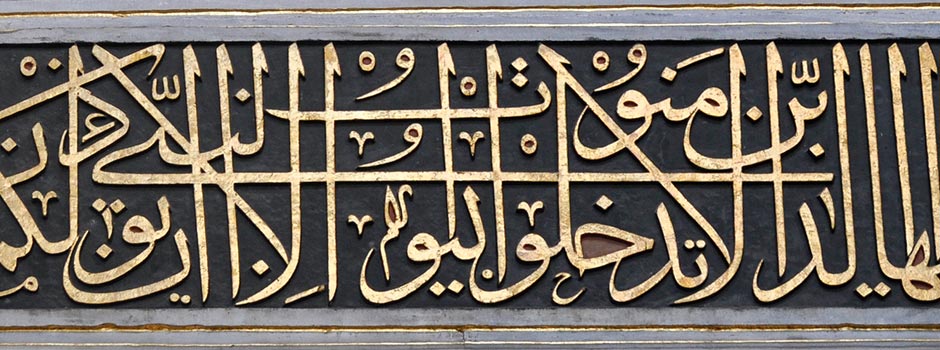
ART HISTORY Inscriptions at the Topkapi Palace in Istanbul
Aug 04, 2020 FEATURE, Art History
This article is part of the project 'Promotion of the Ottoman Cultural Heritage of Bosnia and Turkey' which is organized by Monolit (Association for Promoting Islamic Arts), and supported by the Republic of Turkey (YTB - T.C. BAŞBAKANLIK Yurtdışı Türkler ve Akraba Topluluklar Başkanlığı / Prime Ministry, Presidency for Turks Abroad and Related Communities).
_IslamicArtsMagazine.jpg) Calligraphic inscription, Topkapi Palace / Photo © Islamic Arts Magazine
Calligraphic inscription, Topkapi Palace / Photo © Islamic Arts Magazine
Istanbul is truly a treasure trove of architectural inscriptions (tarihs), with mosque entrances forming the most common locations of such art. However, inscriptions are present in many public monuments too. We should especially mention the inscriptions that decorate the Topkapi Palace, one of the most famous architectural complexes in the world. A large number of inscriptions were created for all the buildings, dedicated to the sultans, or the certain ceremonial / court protocols. To mark that, the inscriptions were created as official consecration. The religious content of the inscriptions proves the strong relationship between the religious and profane, respectively, the religious and political, that were interwoven in the life of the Ottoman court. It should not be forgotten that many processions in the court had an extremely religious character, and were obligatory, even for sultans.
The inscriptions of the Topkapi Palace can be divided chronologically, stylistically, or by the reign during which they were done. The Topkapi Palace, as we see it today, was built gradually over centuries, and it is interesting to note the evolution of styles and tastes concerning architecture, architectural decoration, and calligraphy. Chronologically, the inscriptions were made from the end of the 15th century until the half of the 19th century. Certainly, the inscriptions from the 16th century are not the same as the ones from the 19th century. The change in the style and approach through time is obvious, and some differences are very noticeable. When it comes to the inscriptions from the earlier periods, the ones that dominate are short inscriptions of Qur'anic chapters in the thuluth or jeli-thuluth script. They were all made by the standards of the reformers and artistic geniuses of that time, Ali bin Yahya Sofi, Sheikh Hamidullah and Ahmed Karahisari, that were commissioned to create the calligraphic designs for inscriptions.
_IslamicArtsMagazine.jpg) Calligraphic inscription, Topkapi Palace / Photo © Islamic Arts Magazine
Calligraphic inscription, Topkapi Palace / Photo © Islamic Arts Magazine
Interestingly, the inscriptions from the later periods, especially the ones from the 19th century, are textually voluminous with the poetic dedications to the certain social or political event. Usually written with taliq script, they are very interesting and recognized by the header that contains sultan's tughra. Older Islamic ornaments are almost completely lost here, and the path is given to the medals, volutes, stylized sheets and similar motives that are characteristic for the later Ottoman art. From another point, the quality of taliq script remains exceptional. The author of some of the best inscriptions in taliq script at the Topkapi Palace is the famous calligrapher from the 19th century, Mustafa Rakim. Master of the taliq script, he also specialized in creating tughra, which made him exceptionally famous.
_IslamicArtsMagazine.jpg) Calligraphic inscription, Topkapi Palace / Photo © Islamic Arts Magazine
Calligraphic inscription, Topkapi Palace / Photo © Islamic Arts Magazine
Two of the most famous inscriptions are located above the entrance gates. The first door is called Bab-us-Selam, or the Imperial door. The inscriptions are visible on both sides of the stone entrance. This most dominant inscription at the Topkapi Palace is attributed to Ali bin Yahya Sofi, one of the greatest Turkish calligraphers. It is one of the most difficult calligraphic compositions in the entire history of Ottoman art. The inscription is made in jeli thuluth script, which, according to many people, is the most brilliant style of all Arabic scripts. The artist combined the letters into the most expressive relation, accentuating the artistic effects of the letter elif. For a contemporary observer, this inscription is attractive. The expressed abstract sensibility is very close to contemporary taste, which shows the degree of originality at the time of its creation. Its composition is dual (mirror effect), the favourite composition of the Ottoman artists at the time. There is no fixed visual point, rather there is dynamism of form that is expressed everywhere. Simply, Ali bin Yahya Sofi's work has not been repeated in the art of inscription anymore, but it was used with other forms of calligraphic writings, the one on the paper, above all.
_IslamicArtsMagazine.jpg) Calligraphic inscription, the first entrance, Topkapi Palace / Photo © Islamic Arts Magazine
Calligraphic inscription, the first entrance, Topkapi Palace / Photo © Islamic Arts Magazine
_IslamicArtsMagazine.jpg) Calligraphic inscription, the second entrance, Topkapi Palace / Photo © Islamic Arts Magazine
Calligraphic inscription, the second entrance, Topkapi Palace / Photo © Islamic Arts Magazine
On the second gate of this complex, above the entrance, there is another famous inscription containing „La illahe iIlallah Muhammedu resulullah“ (There is no god but God. Muhammad is the messenger of God.) written on it. This religious text, written in jeli thuluth script, represents the essence of Islam, hence why it was positioned in such a visible place. In the artistic sense, the script is brought to perfection and will be the model for calligraphers for centuries to come.
Comments
Add a comment